check engine JEEP WRANGLER 2015 JK / 3.G Owner's Manual
[x] Cancel search | Manufacturer: JEEP, Model Year: 2015, Model line: WRANGLER, Model: JEEP WRANGLER 2015 JK / 3.GPages: 695, PDF Size: 20.64 MB
Page 619 of 695
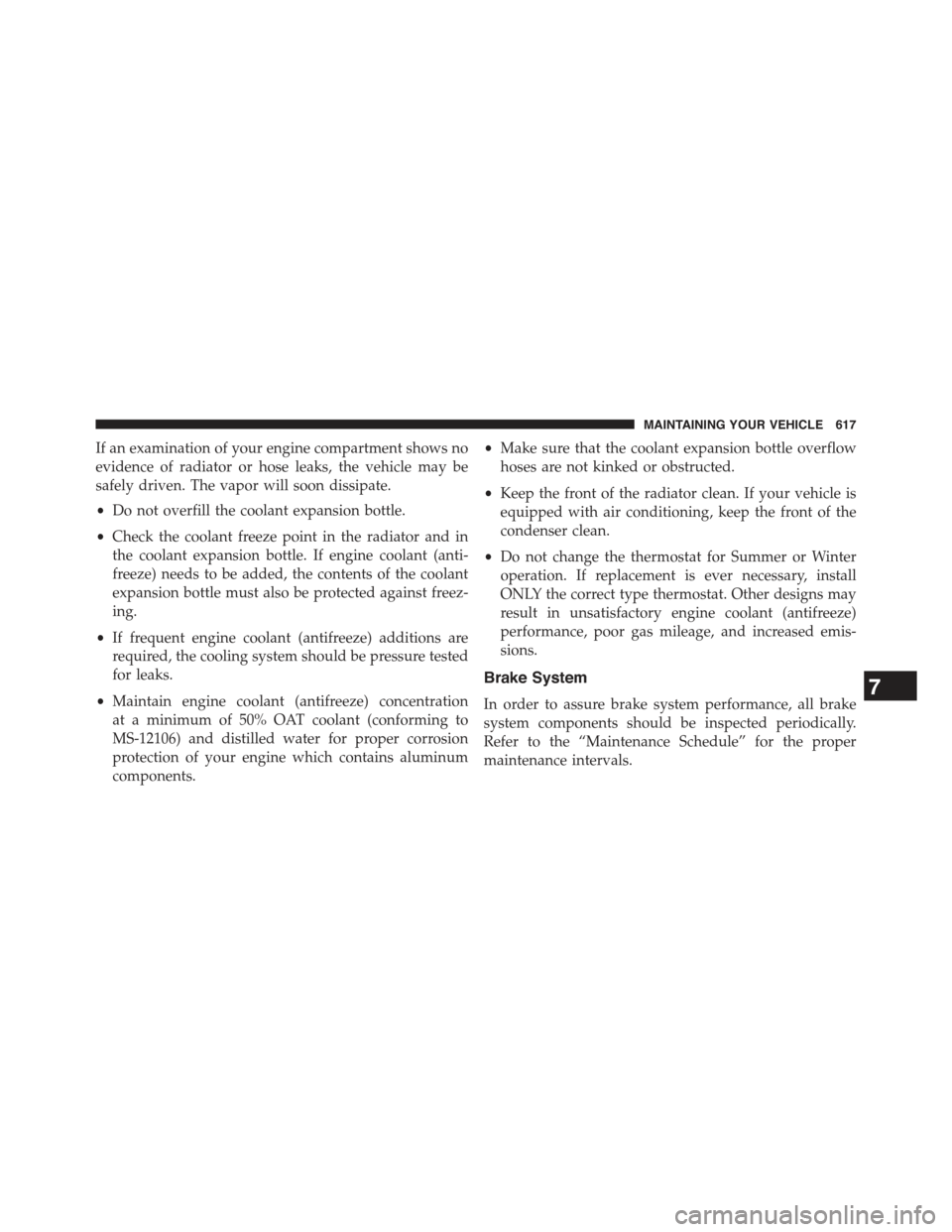
If an examination of your engine compartment shows no
evidence of radiator or hose leaks, the vehicle may be
safely driven. The vapor will soon dissipate.
•Do not overfill the coolant expansion bottle.
•Check the coolant freeze point in the radiator and in
the coolant expansion bottle. If engine coolant (anti-
freeze) needs to be added, the contents of the coolant
expansion bottle must also be protected against freez-
ing.
•If frequent engine coolant (antifreeze) additions are
required, the cooling system should be pressure tested
for leaks.
•Maintain engine coolant (antifreeze) concentration
at a minimum of 50% OAT coolant (conforming to
MS-12106) and distilled water for proper corrosion
protection of your engine which contains aluminum
components.
•Make sure that the coolant expansion bottle overflow
hoses are not kinked or obstructed.
•Keep the front of the radiator clean. If your vehicle is
equipped with air conditioning, keep the front of the
condenser clean.
•Do not change the thermostat for Summer or Winter
operation. If replacement is ever necessary, install
ONLY the correct type thermostat. Other designs may
result in unsatisfactory engine coolant (antifreeze)
performance, poor gas mileage, and increased emis-
sions.
Brake System
In order to assure brake system performance, all brake
system components should be inspected periodically.
Refer to the “Maintenance Schedule” for the proper
maintenance intervals.
7
MAINTAINING YOUR VEHICLE 617
Page 622 of 695
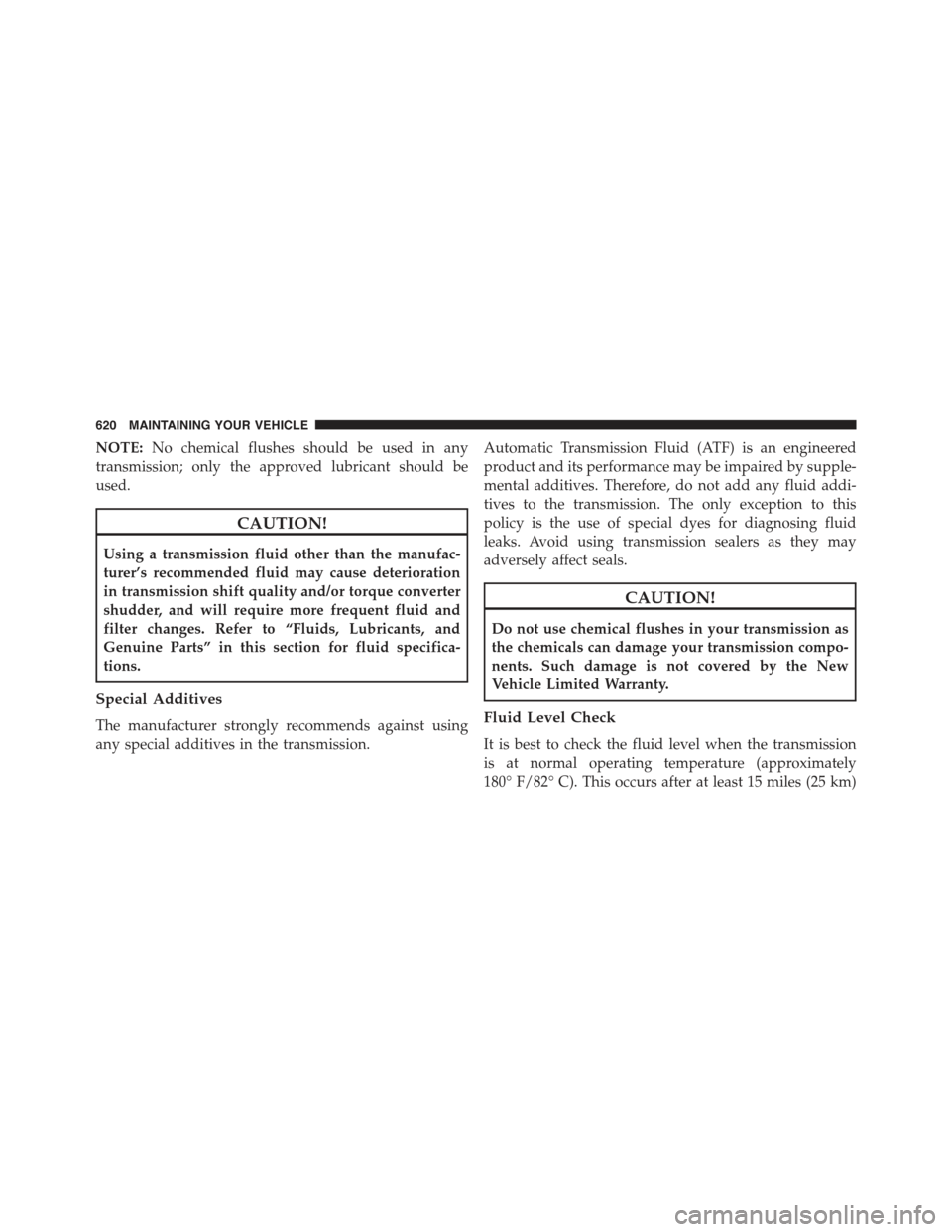
NOTE:No chemical flushes should be used in any
transmission; only the approved lubricant should be
used.
CAUTION!
Using a transmission fluid other than the manufac-
turer’s recommended fluid may cause deterioration
in transmission shift quality and/or torque converter
shudder, and will require more frequent fluid and
filter changes. Refer to “Fluids, Lubricants, and
Genuine Parts” in this section for fluid specifica-
tions.
Special Additives
The manufacturer strongly recommends against using
any special additives in the transmission.
Automatic Transmission Fluid (ATF) is an engineered
product and its performance may be impaired by supple-
mental additives. Therefore, do not add any fluid addi-
tives to the transmission. The only exception to this
policy is the use of special dyes for diagnosing fluid
leaks. Avoid using transmission sealers as they may
adversely affect seals.
CAUTION!
Do not use chemical flushes in your transmission as
the chemicals can damage your transmission compo-
nents. Such damage is not covered by the New
Vehicle Limited Warranty.
Fluid Level Check
It is best to check the fluid level when the transmission
is at normal operating temperature (approximately
180° F/82° C). This occurs after at least 15 miles (25 km)
620 MAINTAINING YOUR VEHICLE
Page 623 of 695
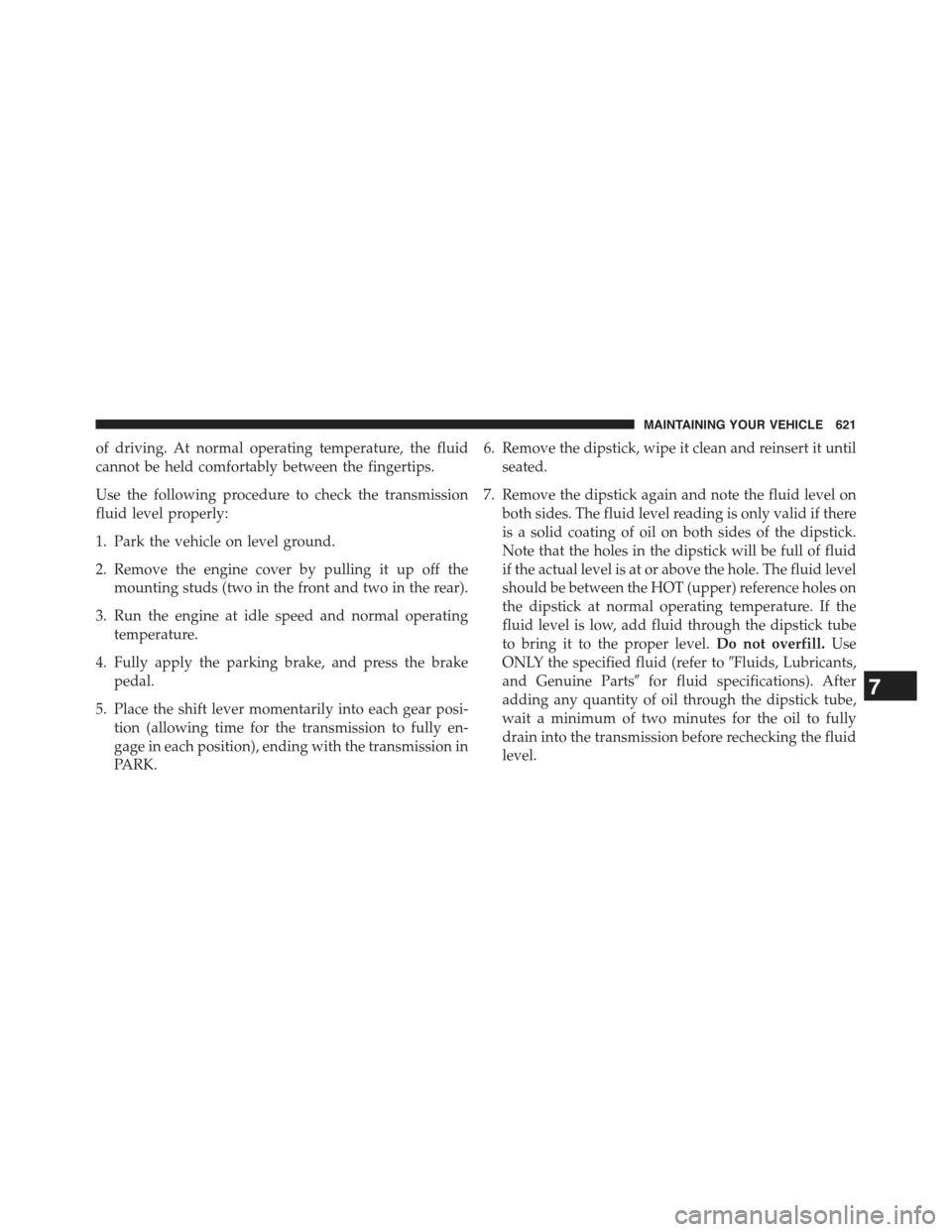
of driving. At normal operating temperature, the fluid
cannot be held comfortably between the fingertips.
Use the following procedure to check the transmission
fluid level properly:
1. Park the vehicle on level ground.
2. Remove the engine cover by pulling it up off the
mounting studs (two in the front and two in the rear).
3. Run the engine at idle speed and normal operating
temperature.
4. Fully apply the parking brake, and press the brake
pedal.
5. Place the shift lever momentarily into each gear posi-
tion (allowing time for the transmission to fully en-
gage in each position), ending with the transmission in
PARK.
6. Remove the dipstick, wipe it clean and reinsert it until
seated.
7. Remove the dipstick again and note the fluid level on
both sides. The fluid level reading is only valid if there
is a solid coating of oil on both sides of the dipstick.
Note that the holes in the dipstick will be full of fluid
if the actual level is at or above the hole. The fluid level
should be between the HOT (upper) reference holes on
the dipstick at normal operating temperature. If the
fluid level is low, add fluid through the dipstick tube
to bring it to the proper level.Do not overfill.Use
ONLY the specified fluid (refer to#Fluids, Lubricants,
and Genuine Parts#for fluid specifications). After
adding any quantity of oil through the dipstick tube,
wait a minimum of two minutes for the oil to fully
drain into the transmission before rechecking the fluid
level.
7
MAINTAINING YOUR VEHICLE 621
Page 624 of 695
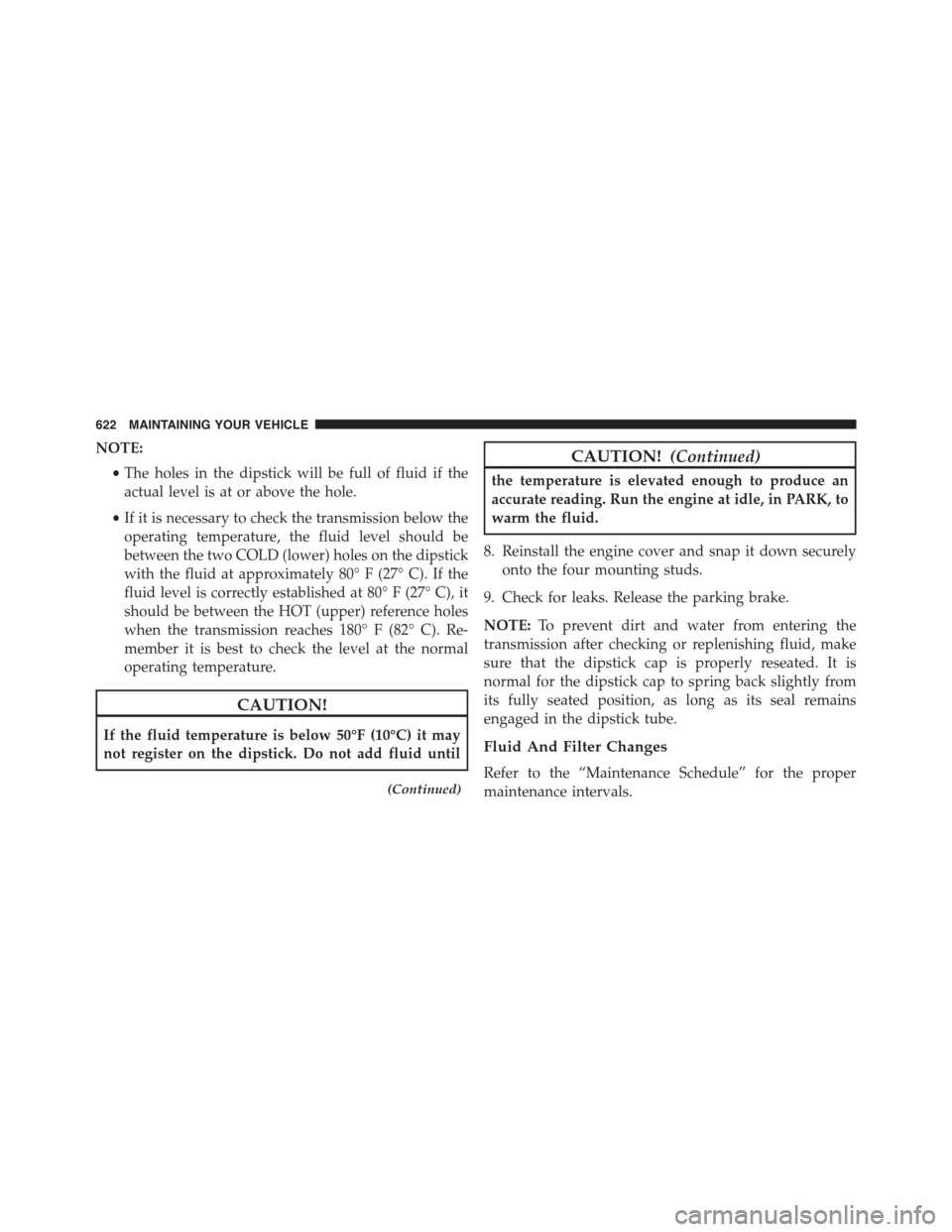
NOTE:
•The holes in the dipstick will be full of fluid if the
actual level is at or above the hole.
•If it is necessary to check the transmission below the
operating temperature, the fluid level should be
between the two COLD (lower) holes on the dipstick
with the fluid at approximately 80° F (27° C). If the
fluid level is correctly established at 80° F (27° C), it
should be between the HOT (upper) reference holes
when the transmission reaches 180° F (82° C). Re-
member it is best to check the level at the normal
operating temperature.
CAUTION!
If the fluid temperature is below 50°F (10°C) it may
not register on the dipstick. Do not add fluid until
(Continued)
CAUTION!(Continued)
the temperature is elevated enough to produce an
accurate reading. Run the engine at idle, in PARK, to
warm the fluid.
8. Reinstall the engine cover and snap it down securely
onto the four mounting studs.
9. Check for leaks. Release the parking brake.
NOTE:To prevent dirt and water from entering the
transmission after checking or replenishing fluid, make
sure that the dipstick cap is properly reseated. It is
normal for the dipstick cap to spring back slightly from
its fully seated position, as long as its seal remains
engaged in the dipstick tube.
Fluid And Filter Changes
Refer to the “Maintenance Schedule” for the proper
maintenance intervals.
622 MAINTAINING YOUR VEHICLE
Page 655 of 695
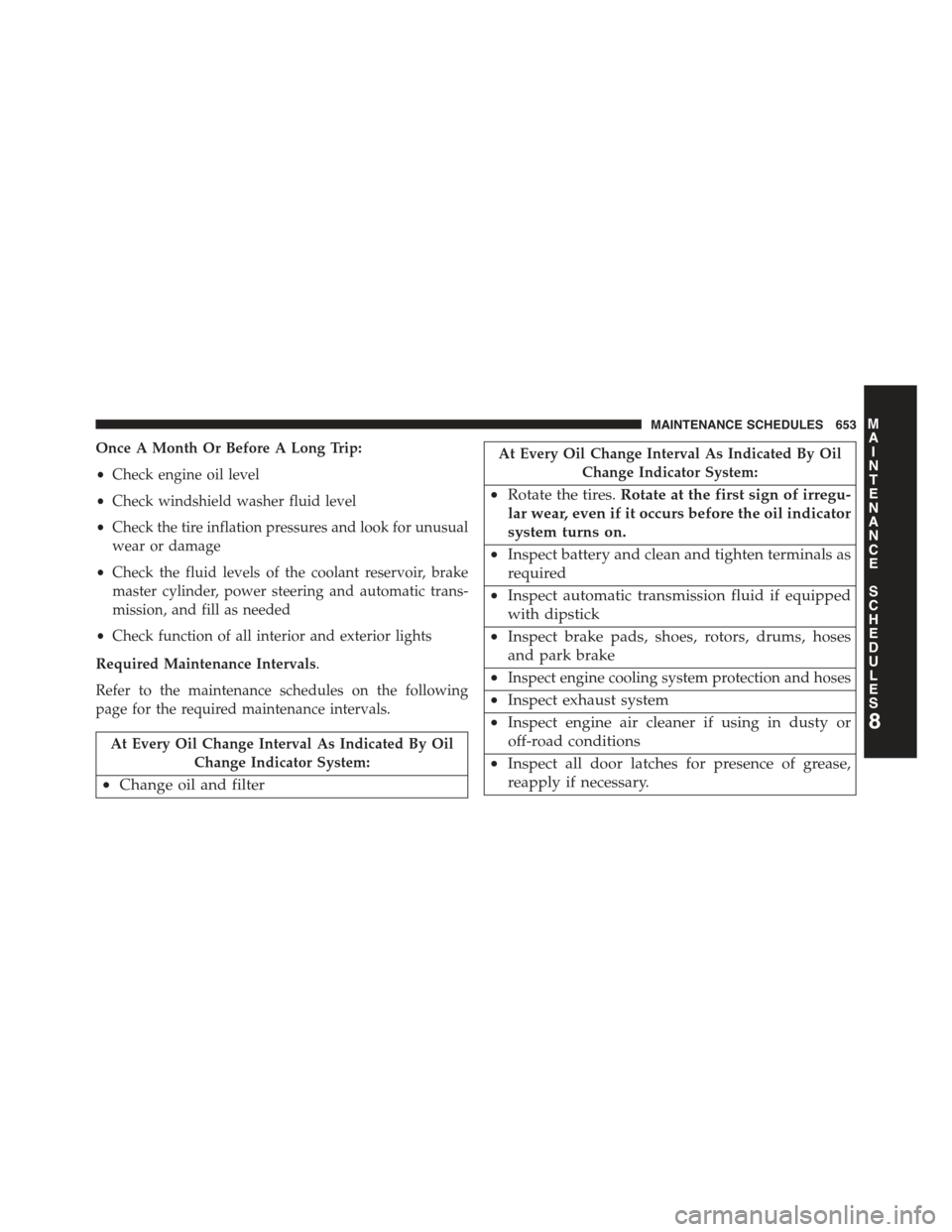
Once A Month Or Before A Long Trip:
•Check engine oil level
•Check windshield washer fluid level
•Check the tire inflation pressures and look for unusual
wear or damage
•Check the fluid levels of the coolant reservoir, brake
master cylinder, power steering and automatic trans-
mission, and fill as needed
•Check function of all interior and exterior lights
Required Maintenance Intervals.
Refer to the maintenance schedules on the following
page for the required maintenance intervals.
At Every Oil Change Interval As Indicated By Oil
Change Indicator System:
•Change oil and filter
At Every Oil Change Interval As Indicated By Oil
Change Indicator System:
•Rotate the tires.Rotate at the first sign of irregu-
lar wear, even if it occurs before the oil indicator
system turns on.
•Inspect battery and clean and tighten terminals as
required
•Inspect automatic transmission fluid if equipped
with dipstick
•Inspect brake pads, shoes, rotors, drums, hoses
and park brake
•Inspect engine cooling system protection and hoses
•Inspect exhaust system
•Inspect engine air cleaner if using in dusty or
off-road conditions
•Inspect all door latches for presence of grease,
reapply if necessary.
8
MAINTENANCE
SCHEDULES
MAINTENANCE SCHEDULES 653
Page 676 of 695
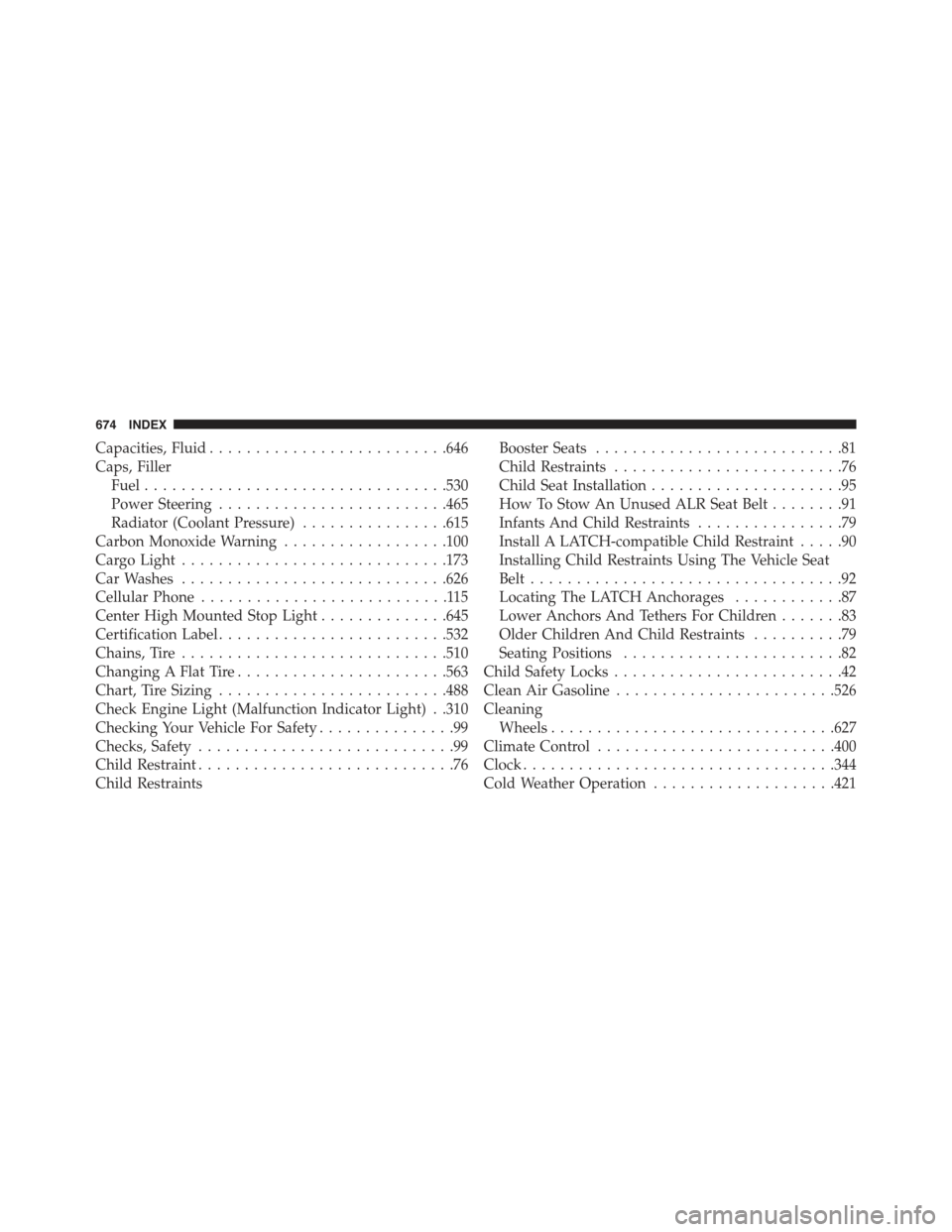
Capacities, Fluid..........................646
Caps, Filler
Fuel.................................530
Power Steering.........................465
Radiator (Coolant Pressure)................615
Carbon Monoxide Warning..................100
Cargo Light.............................173
Car Washes.............................626
Cellular Phone...........................115
Center High Mounted Stop Light..............645
Certification Label.........................532
Chains, Tire.............................510
Changing A Flat Tire.......................563
Chart, Tire Sizing.........................488
Check Engine Light (Malfunction Indicator Light) . .310
Checking Your Vehicle For Safety...............99
Checks, Safety............................99
Child Restraint............................76
Child Restraints
Booster Seats...........................81
Child Restraints.........................76
Child Seat Installation.....................95
How To Stow An Unused ALR Seat Belt........91
Infants And Child Restraints................79
Install A LATCH-compatible Child Restraint.....90
Installing Child Restraints Using The Vehicle Seat
Belt..................................92
Locating The LATCH Anchorages............87
Lower Anchors And Tethers For Children.......83
Older Children And Child Restraints..........79
Seating Positions........................82
Child Safety Locks.........................42
Clean Air Gasoline........................526
Cleaning
Wheels...............................627
Climate Control..........................400
Clock..................................344
Cold Weather Operation....................421
674 INDEX
Page 680 of 695
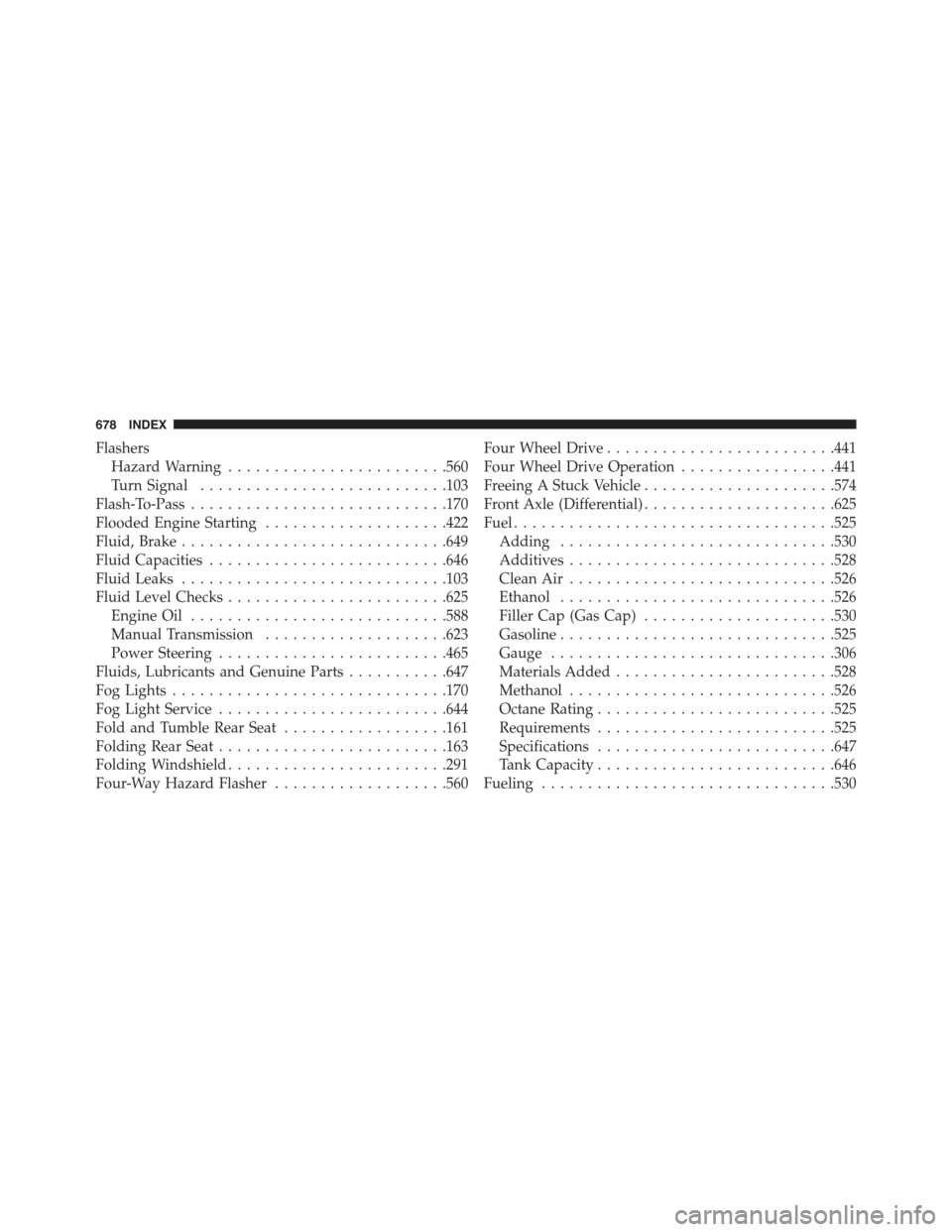
Flashers
Hazard Warning........................560
Turn Signal...........................103
Flash-To-Pass............................170
Flooded Engine Starting....................422
Fluid, Brake.............................649
Fluid Capacities..........................646
Fluid Leaks.............................103
Fluid Level Checks........................625
Engine Oil............................588
Manual Transmission....................623
Power Steering.........................465
Fluids, Lubricants and Genuine Parts...........647
Fog Lights..............................170
Fog Light Service.........................644
Fold and Tumble Rear Seat..................161
Folding Rear Seat.........................163
Folding Windshield........................291
Four-Way Hazard Flasher...................560
Four Wheel Drive.........................441
Four Wheel Drive Operation.................441
Freeing A Stuck Vehicle.....................574
Front Axle (Differential).....................625
Fuel...................................525
Adding..............................530
Additives.............................528
Clean Air.............................526
Ethanol..............................526
Filler Cap (Gas Cap).....................530
Gasoline..............................525
Gauge...............................306
Materials Added........................528
Methanol.............................526
Octane Rating..........................525
Requirements..........................525
Specifications..........................647
Tank Capacity..........................646
Fueling................................530
678 INDEX
Page 683 of 695
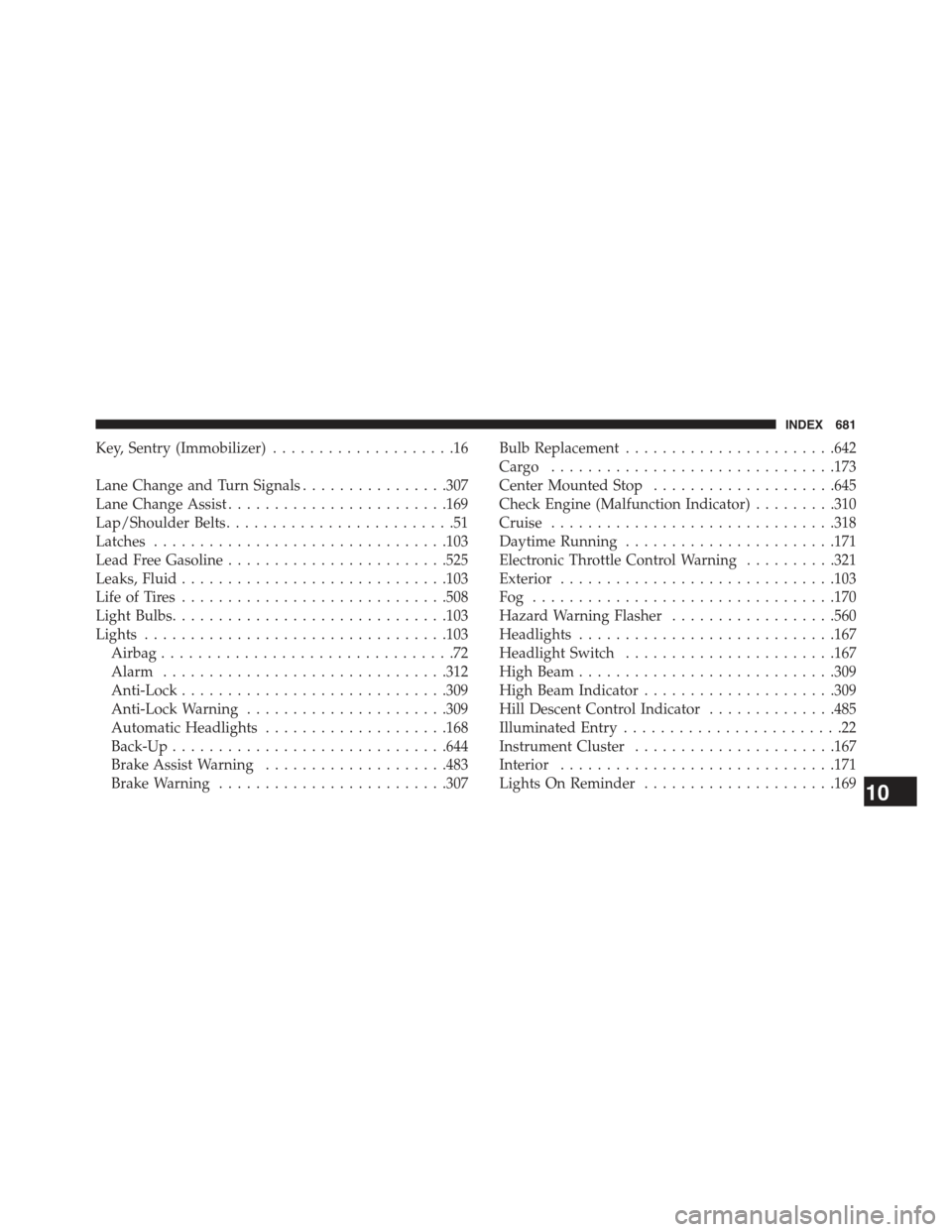
Key, Sentry (Immobilizer)....................16
Lane Change and Turn Signals................307
Lane Change Assist........................169
Lap/Shoulder Belts.........................51
Latches................................103
Lead Free Gasoline........................525
Leaks, Fluid.............................103
Life of Tires.............................508
Light Bulbs..............................103
Lights.................................103
Airbag................................72
Alarm...............................312
Anti-Lock.............................309
Anti-Lock Warning......................309
Automatic Headlights....................168
Back-Up..............................644
Brake Assist Warning....................483
Brake Warning.........................307
Bulb Replacement.......................642
Cargo . . . . . . . . . . . . . . . . . . . . . . . . . . . . . ..173
Center Mounted Stop....................645
Check Engine (Malfunction Indicator).........310
Cruise...............................318
Daytime Running.......................171
Electronic Throttle Control Warning..........321
Exterior..............................103
Fog . . . . . . . . . . . . . . . . . . . . . . . . . . . . . . . ..170
Hazard Warning Flasher..................560
Headlights............................167
Headlight Switch.......................167
High Beam............................309
High Beam Indicator.....................309
Hill Descent Control Indicator..............485
Illuminated Entry........................22
Instrument Cluster......................167
Interior..............................171
LightsOn Reminder.....................16910
INDEX 681
Page 684 of 695
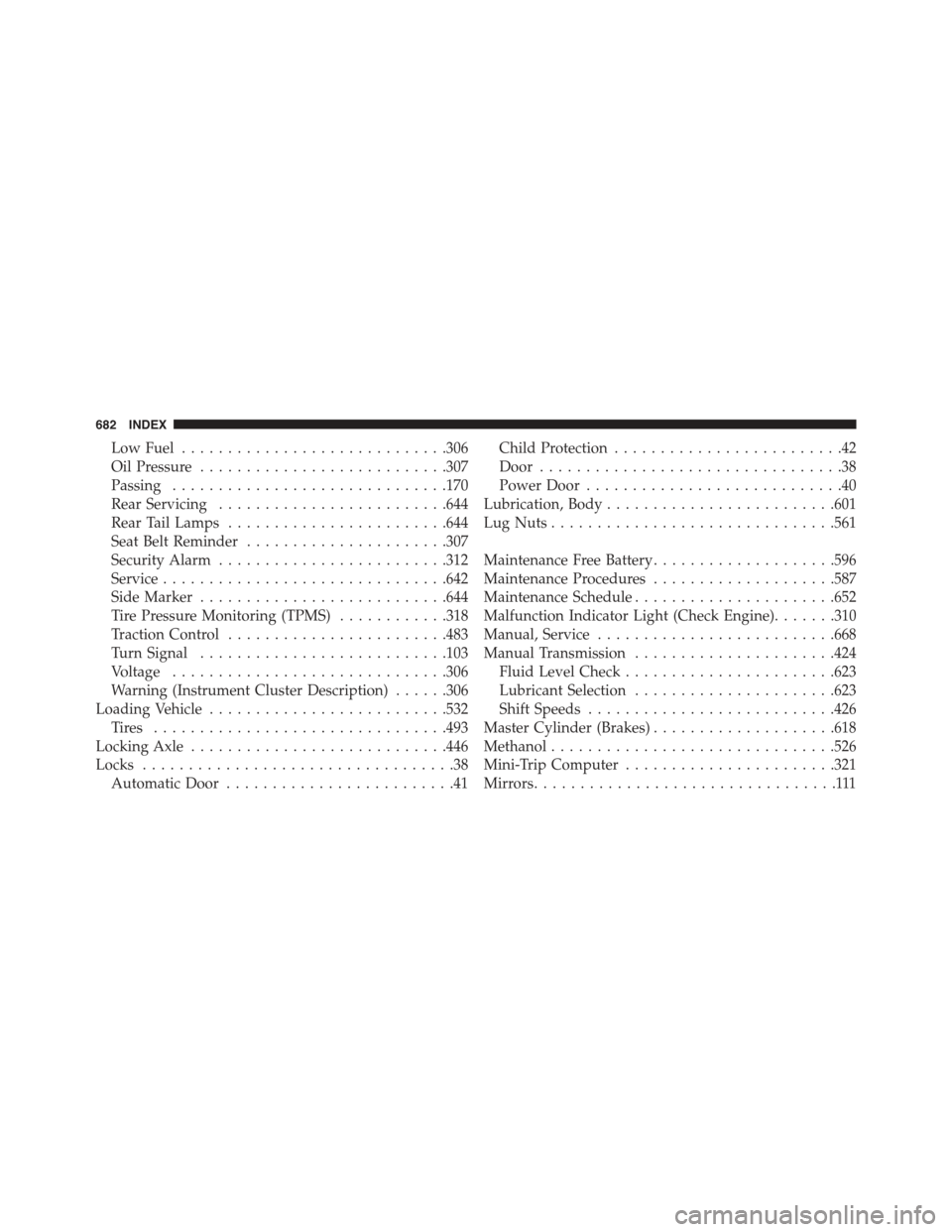
Low Fuel.............................306
Oil Pressure...........................307
Passing..............................170
Rear Servicing.........................644
Rear Tail Lamps........................644
Seat Belt Reminder......................307
Security Alarm.........................312
Service...............................642
Side Marker...........................644
Tire Pressure Monitoring (TPMS)............318
Traction Control........................483
Turn Signal...........................103
Voltage..............................306
Warning (Instrument Cluster Description)......306
Loading Vehicle..........................532
Ti re s . . . . . . . . . . . . . . . . . . . . . . . . . . . . . . ..493
Locking Axle............................446
Locks..................................38
Automatic Door.........................41
Child Protection.........................42
Door.................................38
Power Door............................40
Lubrication, Body.........................601
Lug Nuts...............................561
Maintenance Free Battery....................596
Maintenance Procedures....................587
Maintenance Schedule......................652
Malfunction Indicator Light (Check Engine).......310
Manual, Service..........................668
Manual Transmission......................424
Fluid Level Check.......................623
Lubricant Selection......................623
Shift Speeds...........................426
Master Cylinder (Brakes)....................618
Methanol...............................526
Mini-Trip Computer.......................321
Mirrors.................................111
682 INDEX